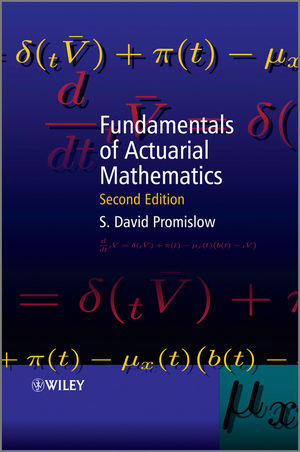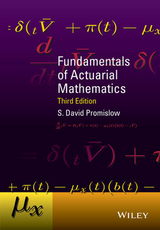
Fundamentals of Actuarial Mathematics
Wiley-Blackwell (Verlag)
978-0-470-68411-5 (ISBN)
- Titel ist leider vergriffen;
keine Neuauflage - Artikel merken
An ideal text for students planning for a professional career as actuaries, providing a solid preparation for the modeling examinations of the major North American actuarial associations. Furthermore, this book is highly suitable reference for those wanting a sound introduction to the subject, and for those working in insurance, annuities and pensions.
Preface. Acknowledgements. Notation index. Part I THE DETERMINISTIC MODEL. 1 Introduction and motivation. 1.1 Risk and insurance. 1.2 Deterministic versus stochastic models. 1.3 Finance and investments. 1.4 Adequacy and equity. 1.5 Reassessment. 1.6 Conclusion. 2 The basic deterministic model. 2.1 Cashflows. 2.2 An analogy with currencies. 2.3 Discount functions. 2.4 Calculating the discount function. 2.5 Interest and discount rates. 2.6 Constant interest. 2.7 Values and actuarial equivalence. 2.8 Regular pattern cashflows. 2.9 Balances and reserves. 2.10 Time shifting and the splitting identity. *2.11 Change of discount function. *2.12 Internal rates of return. *2.13 Forward prices and term structure. 2.14 Standard notation and terminology. 2.15 Spreadsheet calculations. 2.16 Notes and references. 2.17 Exercises. 3 The life table. 3.1 Basic definitions. 3.2 Probabilities. 3.3 Constructing the life table from the values of qx. 3.4 Life expectancy. 3.5 Choice of life tables. 3.6 Standard notation and terminology. 3.7 A sample table. 3.8 Notes and references. 3.9 Exercises. 4 Life annuities. 4.1 Introduction. 4.2 Calculating annuity premiums. 4.3 The interest and survivorship discount function. 4.4 Guaranteed payments. 4.5 Deferred annuities with annual premiums. 4.6 Some practical considerations. 4.7 Standard notation and terminology. 4.8 Spreadsheet calculations. 4.9 Exercises. 5 Life insurance. 5.1 Introduction. 5.2 Calculating life insurance premiums. 5.3 Types of life insurance. 5.4 Combined insurance-annuity benefits. 5.5 Insurances viewed as annuities. 5.6 Summary of formulas. 5.7 A general insurance-annuity identity. 5.8 Standard notation and terminology. 5.9 Spreadsheet applications. 5.10 Exercises. 6 Insurance and annuity reserves. 6.1 Introduction to reserves. 6.2 The general pattern of reserves. 6.3 Recursion. 6.4 Detailed analysis of an insurance or annuity contract. 6.5 Interest and mortality bases for reserves. 6.6 Nonforfeiture values. 6.7 Policies involving a 'return of the reserve'. 6.8 Premium difference and paid-up formulas. *6.9 Universal life and variable annuities. 6.10 Standard notation and terminology. 6.11 Spreadsheet applications. 6.12 Exercises. 7 Fractional durations. 7.1 Introduction. 7.2 Cashflows discounted with interest only. 7.3 Life annuities paid mthly. 7.4 Immediate annuities. 7.5 Approximation and computation. *7.6 Fractional period premiums and reserves. 7.7 Reserves at fractional durations. 7.8 Notes and references. 7.9 Exercises. 8 Continuous payments. 8.1 Introduction to continuous annuities. 8.2 The force of discount. 8.3 The constant interest case. 8.4 Continuous life annuities. 8.5 The force of mortality. 8.6 Insurances payable at the moment of death. 8.7 Premiums and reserves. 8.8 The general insurance-annuity identity in the continuous case. 8.9 Differential equations for reserves. 8.10 Some examples of exact calculation. 8.11 Standard actuarial notation and terminology. 8.12 Notes and references. 8.13 Exercises. 9 Select mortality. 9.1 Introduction. 9.2 Select and ultimate tables. 9.3 Changes in formulas. 9.4 Projections in annuity tables. 9.5 Further remarks. 9.6 Exercises. 10 Multiple-life contracts. 10.1 Introduction. 10.2 The joint-life status. 10.3 Joint-life annuities and insurances. 10.4 Last-survivor annuities and insurances. 10.5 Moment of death insurances. 10.6 The general two-life annuity contract. 10.7 The general two-life insurance contract. 10.8 Contingent insurances. 10.9 Duration problems. 10.10 Applications to annuity credit risk. 10.11 Standard notation and terminology. 10.12 Spreadsheet applications. 10.13 Notes and references. 10.14 Exercises. 11 Multiple-decrement theory. 11.1 Introduction. 11.2 The basic model. 11.3 Insurances. 11.4 Determining the model from the forces of decrement. 11.5 The analogy with joint-life statuses. 11.6 A machine analogy. 11.7 Associated single-decrement tables. 11.8 Notes and references. 11.9 Exercises. 12 Expenses. 12.1 Introduction. 12.2 Effect on reserves. 12.3 Realistic reserve and balance calculations. 12.4 Notes and references. 12.5 Exercises. Part II THE STOCHASTIC MODEL. 13 Survival distributions and failure times. 13.1 Introduction to survival distributions. 13.2 The discrete case. 13.3 The continuous case. 13.4 Examples. 13.5 Shifted distributions. 13.6 The standard approximation. 13.7 The stochastic life table. 13.8 Life expectancy in the stochastic model. 13.9 Stochastic interest rates. 13.10 Notes and references. 13.11 Exercises. 14 The stochastic approach to insurance and annuities. 14.1 Introduction. 14.2 The stochastic approach to insurance benefits. 14.3 The stochastic approach to annuity benefits. *14.4 Deferred contracts. 14.5 The stochastic approach to reserves. 14.6 The stochastic approach to premiums. 14.7 The variance of r L. 14.8 Standard notation and terminology. 14.9 Notes and references. 14.10 Exercises. 15 Simplifications under level benefit contracts. 15.1 Introduction. 15.2 Variance calculations in the continuous case. 15.3 Variance calculations in the discrete case. 15.4 Exact distributions. 15.5 Non-level benefit examples. 15.6 Exercises. 16 The minimum failure time. 16.1 Introduction. 16.2 Joint distributions. 16.3 The distribution of T. 16.4 The joint distribution of (T, J ). 16.5 Other problems. 16.6 The common shock model. 16.7 Copulas. 16.8 Notes and references. 16.9 Exercises. Part III RISK THEORY. 17 The collective risk model. 17.1 Introduction. 17.2 The mean and variance of S. 17.3 Generating functions. 17.4 Exact distribution of S. 17.5 Choosing a frequency distribution. 17.6 Choosing a severity distribution. 17.7 Handling the point mass at 0. 17.8 Counting claims of a particular type. 17.9 The sum of two compound Poisson distributions. 17.10 Deductibles and other modifications. 17.11 A recursion formula for S. 17.12 Notes and references. 17.13 Exercises. 18 Risk Assessment. 18.1 Introduction. 18.2 Utility theory. 18.3 Convex and concave functions: Jensen's inequality. 18.4 A general comparison method. 18.5 Risk measures for capital adequacy. 18.6 Notes and references. 18.7 Exercises. 19 An introduction to stochastic processes. 19.1 Introduction. 19.2 Markov chains. 19.3 Martingales. 19.4 Finite-state Markov chains. 19.5 Notes and references. 19.6 Exercises. 20 Poisson processes. 20.1 Introduction. 20.2 Definition of a Poisson process. 20.3 Waiting times. *20.4 Some properties of a Poisson process. 20.5 Nonhomogeneous Poisson processes. 20.6 Compound Poisson processes. 20.7 Notes and references. 20.8 Exercises. 21 Ruin models. 21.1 Introduction. 21.2 A functional equation approach. 21.3 The martingale approach to ruin theory. 21.4 Distribution of the deficit at ruin. 21.5 Recursion formulas. 21.6 The compound Poisson surplus process. 21.7 The maximal aggregate loss. 21.8 Notes and references. 21.9 Exercises. 22 Credibility theory. 22.1 Introduction. 22.2 Conditional expectation and variance. 22.3 General framework for Bayesian credibility. 22.4 Classical examples. 22.5 Approximations. 22.6 Conditions for exactness. 22.7 Estimation. 22.8 Notes and references. 22.9 Exercises. 23 Multi-state models. 23.1 Introduction. 23.2 The discrete-time model. 23.3 The continuous-time model. 23.4 Notes and references. 23.5 Exercises. Appendix A review of probability theory. A.1 Introduction. A.2 Sample spaces and probability measures. A.3 Conditioning and independence. A.4 Random variables. A.5 Distributions. A.6 Expectations and moments. A.7 Expectation in terms of the distribution function. A.8 The normal distribution. A.9 Joint distributions. A.10 Conditioning and independence for random variables. A.11 Convolution. A.12 Moment generating functions. A.13 Probability generating functions. A.14 Mixtures. Answers to exercises. References. Index.
| Erscheint lt. Verlag | 20.12.2010 |
|---|---|
| Zusatzinfo | Illustrations |
| Verlagsort | Hoboken |
| Sprache | englisch |
| Maße | 178 x 250 mm |
| Gewicht | 928 g |
| Themenwelt | Mathematik / Informatik ► Mathematik |
| Betriebswirtschaft / Management ► Spezielle Betriebswirtschaftslehre ► Versicherungsbetriebslehre | |
| ISBN-10 | 0-470-68411-9 / 0470684119 |
| ISBN-13 | 978-0-470-68411-5 / 9780470684115 |
| Zustand | Neuware |
| Haben Sie eine Frage zum Produkt? |
aus dem Bereich



